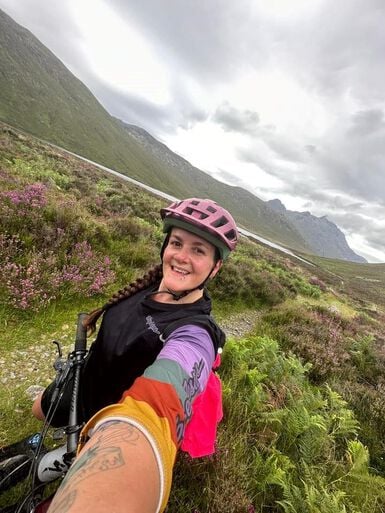Coil vs air shocks: Exploring the differences
Every mountain biker wants to master the art of ‘just right’ suspension, but which is best between a coil vs air shock? In this guide we’ll dig into the pros and cons of each to help you decide.


The decision between a coil vs air shock mountain bike suspension is not necessarily about which is faster – but more about how it feels.
Most full suspension mountain bikes come fitted with air spring shocks because they’re easier to manufacture with increased tunability out of the box, but coil is becoming more common for downhill and enduro.
While both coil and air shock systems do the same job of supporting you and the bike through rough terrain, there are key differences in ride feel, tunability, performance and maintenance – as well as actual compatibility with your bike – that will be the deciding factor.
Contents
Understanding coil and air shocks
The most obvious difference between coil shocks vs air shocks is how they look.
Coil shocks have a steel or titanium spring coil around the rear shock body that compresses for support on the trail, while air shocks use compressed air in a chamber, contained by tight seals.
Coil shocks are heavier, with a stiffer and more consistent spring rate than the lively and progressive air shock. Traditionally, coil suspension was only found on downhill bikes – where weight doesn’t matter but damper consistency absolutely does – for constant, predictable support on long and demanding race runs.
But in recent years, there’s been a resurgence of coil shocks on hard-hitting enduro bikes, including on versions of our Torque and race-winning Strive.
Performance comparison: Air vs coil
If you were to score just the performance of an air vs coil shock, the coil would come out on top for consistency because of its linear spring rate. This means the amount of force needed to compress the spring increases in a consistent, linear way throughout the whole suspension stroke.
For example, a 400lb spring requires 400lb of force to compress it by one inch, 800lb for two inches, 1200lb for three, and so on.
Less reliance on seals holding in pressurised air means less friction, less heat build up, and greater small bump sensitivity. This gives constant, predictable support for a stiffer ride over long, rough descents, where consistency and reliability matters.
Air shocks, on the other hand, have a more progressive spring rate, so the shock gives more support (or ‘ramps up’) the further you go into the travel. This ramp up at the end gives better bottom out resistance compared to a coil shock, but can be less predictable on long descents and rough, rugged trails.

Weight, tunability, and ride feel assessment
Obviously, metal weighs more than air so it’ll come as no surprise that coil shocks are heavier (around 500g), but they’re mostly used on downhill and big travel enduro bikes, where weight isn’t a consideration.
Tuning an air shock
A key difference between an air vs coil shock is tunability.
An air shock is infinitely tuneable with a shock pump by adding or removing air pressure to adjust the sag. Too much air (sag too hard) will feel rigid and bounce off the trail like a hardtail; not enough air (sag too soft) will feel sluggish and sink too far into every dip.
The aim is to set the correct sag to the rider weight, and you’ll find guidance on required air pressure for different body weight measurements on the shock body or manufacturer’s website.
When to use volume spacers
Further air shock tunability can be achieved with volume spacers. These are useful if you bottom out on your shock a lot, or if you never use the full range of suspension even though the sag is set correctly.
Volume spacers are small pieces of plastic fit inside the shock body to reduce air volume and increase the spring rate at the end of the stroke which boosts bottom out resistance.
Removing spacers increases the air volume and decreases the end spring rate, allowing the bike to use the full range of suspension without reducing air pressure or adjusting sag.

Tuning a coil shock
Unlike the infinite tunability of an air shock, tuning a coil shock is more of a one-time job, setting the correct spring rate for the bike, rider weight and riding style.
Because of the linear spring rate, it doesn’t ramp up in the end stroke like an air shock does, so you can’t adjust bottom out support. The only way to change it is to change the physical spring, making sure it’s the correct spring weight for the rider weight (see manufacturer for guidance).
Adjusting the preload on a coil shock (usually a dial at the top of the shock body) changes the amount of force needed to compress the spring. Most manufacturers allow up to five turns per spring - if you need to go above that to get your desired sag, it’s likely you’ll need a heavier spring.
Ride feel: Air shock vs coil shock
In terms of how both air vs coil shock suspension systems feel on the bike, the coil feels smoother, quieter and more planted to the ground over small bumps, rough terrain and big hits.
The air shock on the other hand, feels more playful, poppy and agile, quicker in and out of corners with a more of a progressive kick on the mid to end stroke.
Of course, how a mountain bike feels to ride is not solely down to the suspension alone, but the overall geometry. Learn more about mountain bike geometry in this guide.

Maintenance: Advantages and drawbacks
When servicing coil shocks vs air shocks, there are a few differences in requirements.
Air shocks typically need more maintenance than coil shocks due to the seals, because they’re prone to heat build up from friction on long, rough descents. This friction can overheat the oil in the damper and make the shock feel inconsistent with reduced small bump sensitivity.
Air shock servicing is needed on both the air chamber and the damper, to retain maximum performance, whereas the coil system has fewer seals and the linear spring rate makes heat build up less of an issue, so requires less maintenance – you only have to service the damper on a coil shock.
Compatibility check: Is your bike ready for coil or air?
Because most mountain bikes are designed to work with an air shock, only some frames will be compatible with coil suspension. Whether coil suspension will work is down to the suspension kinematics and leverage curve of the bike, as well as the space in the frame.
The leverage curve (also known as ratio), is a measure of how far the rear wheel moves in relation to the shock. If the leverage curve of the bike is too linear, you could find you sit too far into the travel too often on a coil shock, making the bike feel sluggish and frequently bottoming out.
That’s why coil shocks are best on bikes with progressive leverage curves, and air shocks on frames with linear leverage curves.
If you’re thinking of swapping out your coil or air shock suspension, check with the manufacturer to make sure it’s compatible.
Which to choose: Coil vs air shock?
If you’re racing enduro or downhill, or regularly ride long, rough descents, where weight is not a priority, and you want to feel more planted, a coil shock will give you reliability and confidence to go hard.
If you’re more concerned with pedal efficiency and want more agile, playful and tuneable support from your suspension, an air shock will deliver.
Or, why not have both?! Some enduro mountain bikes are compatible with both air and coil shocks, so you can swap out your suspension to suit the type of riding – like our Strive CFR Ltd, with RockShox Super Deluxe Ultimate air and coil components for huge traction and maximum control.
In summary:
Coil shock pros:
- Linear, consistent support on long, rough descents.
- Better small bump sensitivity.
- Closer traction to the ground.
- Less maintenance.
- More durable.
Coil shock cons:
- Heavier (around 500g).
- Less adjustability - have to change spring each time.
- More expensive buying different springs.
- Not compatible with all frames.
Air shock pros:
- Infinitely tunable using a shock pump.
- More affordable - most full suspension mountain bikes come fitted with air shocks.
- Lighter and more pedal efficient.
- Better (and adjustable) bottom out support.
- Can be better on jumps with supported landings.
Air shock cons:
- Prone to heat build up and friction in the seals on long descents.
- Need more maintenance.
- Can be sensitive and inconsistent in hot weather.
If you're feeling overwhelmed and unsure where to begin, check out our mountain bike buyer’s guide and Canyon bikes comparison tool. These resources will guide you through the different Canyon bike models and their specifications.
Discover our Mountain Bikes
Did this article help?
Thank you for your feedback
-
 About the author
About the authorTess Agnew
Tess is a freelance copywriter, social media and communications pro based in Brighton with a passion for the outdoors and the mental health benefits it brings.
















